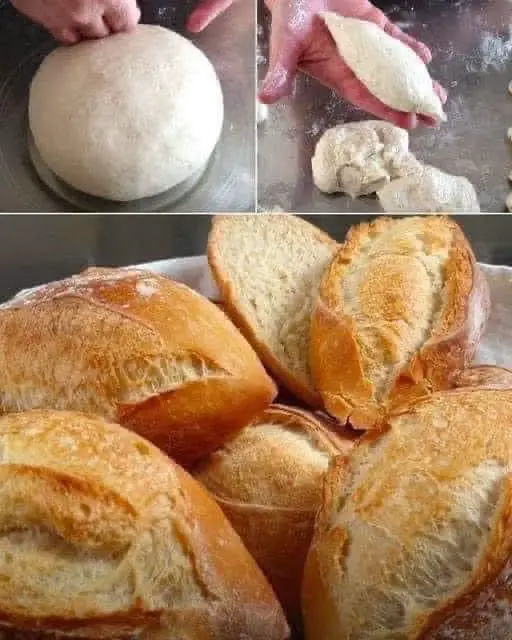Homemade Bread Rolls Recipe
Ingredients:
- 500 grams all-purpose flour
- 300 grams water
- 4 grams brewer’s yeast (or active dry yeast)
- 1 tablespoon honey
- 8-10 grams salt
Method:
- Dissolve Yeast: In a bowl, dissolve the yeast in the water with the honey.
- Mix Flour and Yeast: In a large mixing bowl, add the flour, then pour in the yeast mixture. Start mixing.
- Add Salt: Once the mixture starts to come together, add the salt and continue mixing until a soft and homogeneous dough forms.
- Let Dough Rise: Cover the bowl with plastic wrap and let the dough rise for 12 hours in the fridge.
- Divide Dough: After 12 hours, remove the dough from the fridge and divide it into equal pieces.
- Shape Rolls: Shape each piece of dough into rolls and place them on a baking tray. Leave to rest for 1 hour.
- Make Cuts: Make a side cut on each roll and sprinkle some flour on top.
- Preheat Oven: Preheat the oven to 230°C (450°F).
- Bake with Water: Place a saucepan of water on the bottom rack of the oven. Bake the rolls at 230°C (450°F) for 10 minutes.
- Remove Saucepan: After 10 minutes, remove the saucepan from the oven and continue to bake the rolls until they are golden brown.
- Enjoy: Once golden brown, remove the rolls from the oven and let them cool slightly. Enjoy your Homemade Bread Rolls!
These homemade bread rolls are perfect for sandwiches, burgers, or simply enjoyed on their own with butter or jam.
Tips for Perfect Homemade Bread Rolls:
- Use High-Quality Ingredients: Choose high-quality flour, yeast, and salt for the best results. Fresh yeast will yield better rise and flavor, but active dry yeast can be used as a substitute.
- Knead the Dough Properly: Ensure that you knead the dough until it becomes soft, smooth, and elastic. Proper kneading helps develop gluten, which gives the rolls structure and texture.
- Allow Sufficient Rising Time: Letting the dough rise for 12 hours in the fridge allows for a slow fermentation process, which enhances flavor and texture. This step cannot be rushed, so plan accordingly.
- Keep an Eye on Oven Temperature: Preheat your oven to the correct temperature (230°C/450°F) and monitor it throughout the baking process to ensure even baking and a golden brown crust.
- Use Steam for a Crisp Crust: Placing a saucepan of water in the oven during baking creates steam, which helps develop a crispy crust on the bread rolls.
- Customize Toppings: Experiment with different toppings such as sesame seeds, poppy seeds, or coarse salt to add flavor and visual appeal to your bread rolls.
- FAQs (Frequently Asked Questions):
- Q: Can I use instant yeast instead of brewer’s yeast or active dry yeast?
- A: Yes, you can use instant yeast as a substitute for brewer’s yeast or active dry yeast. Instant yeast can be added directly to the flour without needing to be dissolved in water first.
- Q: Can I freeze the dough or baked bread rolls?
- A: Yes, you can freeze both the dough and baked bread rolls. For the dough, shape it into rolls, then freeze on a baking tray. Once frozen, transfer the rolls to a freezer bag or container. To bake, let the frozen dough thaw in the refrigerator overnight, then proceed with baking as directed. Baked bread rolls can be wrapped tightly in plastic wrap and aluminum foil before freezing. Thaw at room temperature and reheat in the oven before serving.
- Q: My dough didn’t rise much. What went wrong?
- A: Several factors can affect dough rise, including the freshness of the yeast, temperature, and kneading technique. Ensure your yeast is not expired and that the water used is at the correct temperature (around 110°F/43°C) for activating the yeast. Proper kneading and sufficient rising time are also essential for good rise.
- Q: Can I make these bread rolls gluten-free?
- A: Yes, you can make gluten-free bread rolls by using a gluten-free flour blend and ensuring all other ingredients are gluten-free. Keep in mind that the texture and rise may differ from traditional wheat-based rolls, so experimentation may be needed to achieve the desired results.

